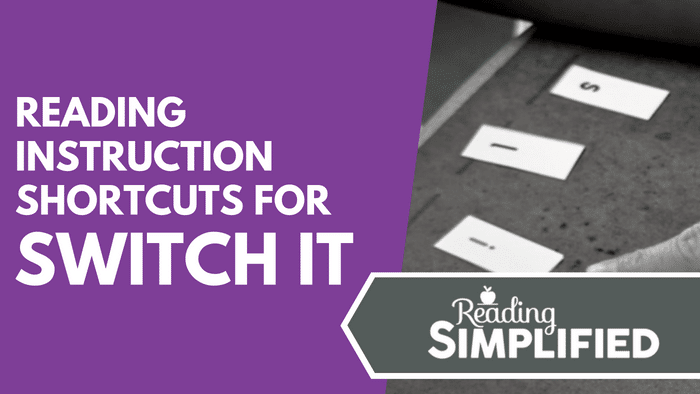
Are you struggling to get the most out of reading instruction time with your kids?
Maybe you’ve got 20 minutes or less to work on their phonemic segmentation and phonemic manipulation skills, but you’re crunched for time?
I know the feeling!
It can be so frustrating when you’re only halfway through the lesson, and the school bell interrupts reading instruction time!
Unfortunately, you can’t stop the bell from ringing (trust me, I’ve tried!). But, you CAN save a lot of time in your small group reading instruction with just one activity – Switch It.
If you’ve been a part of the Reading Simplified family for a while now, chances are, you’ll know all about Switch It. But if you’ve never heard of it, I’m going to teach you how it’s done and give you some great tips to make this simple activity even more efficient.
So, if you want to know how you can get as much instructional reading done as possible in a short period (and accelerate your kids’ reading achievement) keep reading! Or if you'd prefer to watch me talk you through Switch It - hit play on the video below:
What is Switch It?
Switch It is one of the main activities we teach here at Reading Simplified.
It’s straightforward to teach, and kids love it too!
The activity works by asking students to switch singular sounds in and out of words with a focus on sound-symbol correspondence.
The student begins with a word such as “SLED,” and the teacher calls out a switch which goes something like this…
“Switch SLED to SLID”
…then the student makes the switch!
When SLED becomes SLID, the student has to segment each sound in the word to create the new word.
SLID would then become SLIT, SPIT, and SPOT, etc.
As each position of the word changes, the student works on their phonemic segmentation and phonemic manipulation skills. On top of this, they’re also practicing short vowel letter-sound knowledge and so much more.
Shortcuts for Switch It
When it comes to reading instruction, every minute counts.
Switch It is key for squeezing the juice out of every second you have of small-group reading instruction. It’s a dynamic activity, which means you can integrate a lot in a single setting including:
- Left to right processing
- Concept of print
- Phonemic segmentation
- Phonemic manipulation
- Consonant letter-sound knowledge
- Short-vowel letter-sound knowledge
- Decoding and spelling
With Switch It, you can forgo isolated activities and teach students all of these pre-reading skills at the same time.
If your students are in kindergarten or even younger than that, they can rely on Build It. Build It is a predecessor to Switch It and perfect for younger readers. If you want to learn more about the Build It activity, visit readingsimplified.com/start-here.
Want to find out how you can get the most out of your reading instruction time with the Switch It activity?
Here’s a collection of shortcut tips for Switch It:
Prep your word list and letter-cards ahead of time
Don’t waste time prepping your word list at the beginning of your reading instruction time. Prepare your word list before the students gather at your table. Make sure to select words that address their most pressing need. So, if they have problems with short vowel letter-sound knowledge, choose words that will help develop that skill.
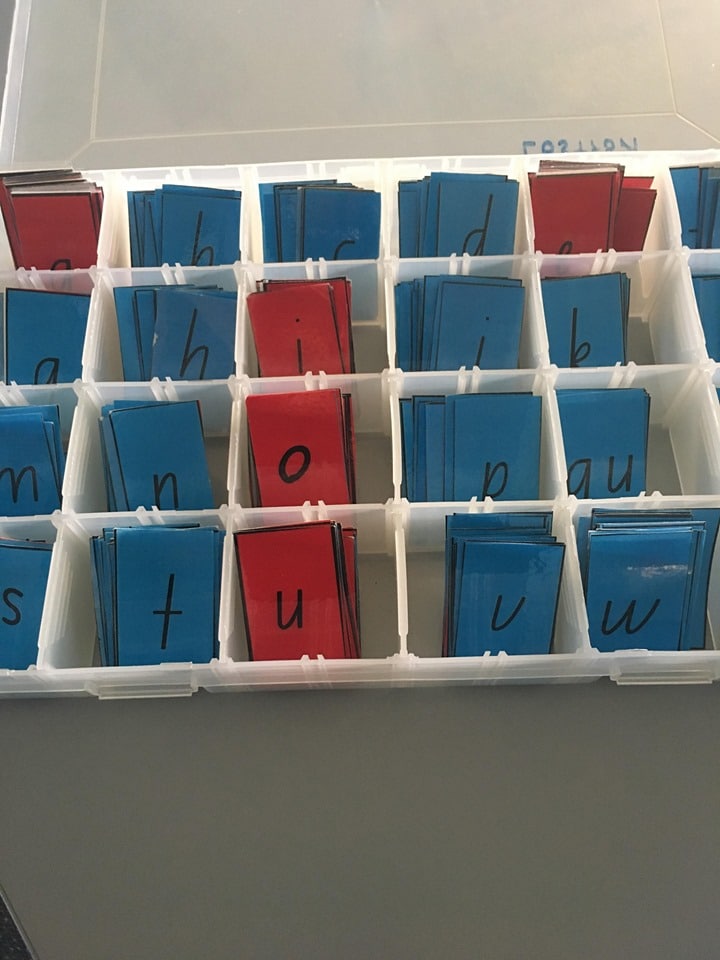
Stop using letter-cards (after a few weeks)
Once your students get more practice with letter-sounds and they “get the code,” it’s time to say goodbye to letter-cards! Instead, try using a dry erase board. This will save you a lot of time because the students can erase and replace letters as they go.
Have students cover their board
When working with a small group, you might notice some kids trying to peek at their neighbor’s board. If they’re copying the answers, they aren’t learning anything for themselves, and they become dependent on the other students to help them work it out. So, encourage students to cover their boards to rule out any copying!
If a child struggles more than others, work with them one to one
It’s normal for one or two kids to fall behind the rest of the group. Don’t panic! Just pull that student to the side for five minutes for a one-on-one session. Work on the Switch It activity like this for five days or a few weeks until the kid is back up to the same level as the rest of the group.
Give everyone the same list of words
In small-group reading instruction, it’s better to give every student the same list of words at the same time. It’s too confusing to make multiple lists for multiple students. Keep it simple.
Add new letter-sounds EVERY day
Traditional reading programs usually want you to add new letter-sounds at a much slower pace, but our kids can handle a lot more than that. Accelerate reading achievement by introducing new letter-sounds every day. If your kids are confident, you could even add several new letter-sounds each day!

Increase phonemic difficulty regularly
Switch It doesn’t force kids to stay on the same CVC words forever. It moves things forward and increases phonemic difficulty much faster than most reading programs. Most students can get to CCVCC words in less than two weeks – so don’t be afraid to move onto more phonemically challenging words such as STOMP and STRAND.
Bump up a level during a lesson where possible
Remember - we want our kids to make mistakes. If they aren’t making any mistakes, the level isn’t hard or challenging enough for them. So, if you think your students are flying through the levels, don’t hesitate to bump them up!
Watch their eyes and have them rotate seats
Since you’re doing the Switch It activity, why not switch things up a bit? Have your kids rotate seats to help refresh their minds. Keep an eye on their eyes – are they focused on their own boards or do they look confused? If you notice a student looking everywhere BUT their board, that’s a clear sign they might need some extra help!
Put the letter-cards away yourself
It may be tempting to ask the kids to clean up their letter-cards before the bell rings, but this only takes up valuable reading time! Make the most out of each second you have with your students and clean up the cards yourself once the lesson has ended.
Don’t let vocabulary meanings eclipse decoding instruction
On the one hand, a good teacher is casually teaching about word meanings all day long. Practically with every breath, s/he should define words that may be unusual or elaborate on a word in a new sentence. Most of us probably need to do this more! On the other hand, when students are in a period of learning how to crack the code, vocabulary instruction during decoding Word Work time should be present, but not dominating.
What do I mean?
Unless you have ELL students, don't let vocabulary instruction--in this context--take up more time than the actual Switching. Yes, it’s super important to define or elaborate on each word, so each word has a connection to real meaning. However, it's also a slippery slope...it's so easy to spend 1 minute on vocabulary instruction for every 20 seconds of switching of sounds.
The words in our Switch It lists were selected for their utility in teaching phonological decoding sub-skills--they're not high-impact vocabulary words. SO, routines of deep instruction in vocabulary should, for the most part, take place during other lessons, such as interactive read alouds and vocabulary meaning word study.
And there you have it; now you can save a ton of time and accelerate your kids’ reading achievement with one activity – Switch It!

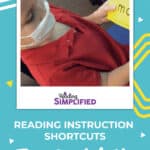
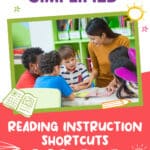

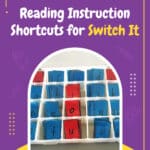
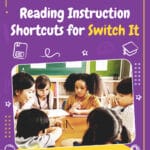

Are there any word lists made in french?
Hi Kayla! I DO believe these strategies work with any alphabetic language based on theories and research of reading development. However, I haven’t implemented them in another language myself, and do not currently have any resources in any foreign languages. We do have a few French immersion teachers inside our Reading Simplified Academy who are testing our core techniques out. So far it seems positive.
I would test out Switch It first, to see if you can adapt that: ReadingSimplified.com/integrate-dont-isolate
What’s the best way to organize the letter sound cards for small group instruction? I don’t want to waste instructional time having the kids look for all the letters but am trying to decide the best way to have the letters ready for the group.
I like to use a craft box and have the letter-sounds ready at the start of the lesson. Some teachers make baggies or envelopes of the letter-sounds for each word list, though.
After a few weeks of this activity, you can transition to just white boards and dry erase markers because they know the code well–now they just need lots of practice with phonemic manipulation. So, they just erase 1 sound at a time and re-write the correct one over that.
I have the Switch It Guide. I love it. Are there more levels that can be purchased?
If it goes higher than the free set I got, I would like to purchase it.
Thanks for your interest, Kris! Most of our materials are on reserve for members of our Reading Simplified Academy. If you’d like to learn more about it, check this out: ReadingSimplified.com/start-here
I love the switch it game. I work with SPED kids and in on e of my groups we have advanced to ‘silent e’ words. Do you have a list for silent e words?
Glad it’s working well for them! We keep Switch It with just the short vowels because they enable us to push to the hardest levels of phonemic difficulty, i.e., CCCVCC and even CCCVCCn nonsense words. However, we teach silent e words in the context of an activity Sort It, which you can learn about here.
I started using Switch It with my reading group and they love it. It’s a really great concept and I am delighted with it.
Regards,
So glad it’s serving your readers well!
Curious, do you ever just give them the name of the sound (or the letter name) in Switch It? For example, instead of “sled to slid,” the prompt woul be, “Change /e/ to /i/. Now what word do you have?” or “Change the “e” to “i.” Now what world do you have?”
That’s the more traditional way of doing Making Words. It’s a fine variation! But it targets the child’s blending ability, which we focus on in Read It and Sort It. For Switch It, we’re especially targeting phonemic manipulation so the child develops the cognitive flexibility to play around with sounds in words. This is a hallmark skill of good readers called “Set for Variability” and Switch It is one part of our formula that develops that word attack skill.
I cant wait to try the game but I don’t want to make the letter cards. Do you know where I can purchase them? Also would digraphs be on one card like ch; wh; etc.?
Thanks so much!
Hi LouAnn! Yes, the digraphs would be on one card. You can snag a free PDF of our letter-sound cards here:
Readingsimplified.com/childs-worldview